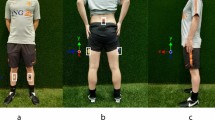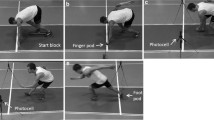Abstract
Impaired postural control (PC) is an important feature of Parkinson’s disease (PD), but optimal testing protocols are yet to be established. Accelerometer-based monitors provide objective measures of PC. We characterised time-dependent changes in PC in people with PD and controls during standing, and identified outcomes most sensitive to pathology. Thirty-one controls and 26 PD patients were recruited: PC was measured with an accelerometer on the lower back for 2 minutes (mins). Preliminary analysis (autocorrelation) that showed 2 seconds (s) was the shortest duration sensitive to changes in the signal; time series analysis of a range of PC outcomes was undertaken using consecutive 2-s windows over the test. Piecewise linear regression was used to fit the time series data during the first 30 s and the subsequent 90 s of the trial. PC outcomes changed over the 2 mins, with the greatest change observed during the first 30 s after which PC stabilised. Changes in PC were reduced in PD compared to controls, and Jerk was found to be discriminative of pathology. Previous studies focusing on average performance over the duration of a test may miss time-dependent differences. Evaluation of time-dependent change may provide useful insights into PC in PD and effectiveness of intervention.




Similar content being viewed by others
Notes
Axivity AX3, York, UK.
PAL Technologies, Glasgow, UK.
BSN Medical Limited, Hull, UK.
Abbreviations
- ABCs:
-
Activities-specific balance confidence scale
- ANCOVA:
-
Analysis of covariance
- AP:
-
Anteroposterior
- BMI:
-
Body mass index
- CL:
-
Controls
- f95%, CoP:
-
Centre of pressure frequency below which is 95 % of power of the acceleration power spectrum
- GDS:
-
Geriatric Depression Scale
- Hz:
-
Hertz
- LEDD:
-
Levodopa equivalent daily dose
- MDS-UPDRS:
-
Movement Disorder Society version of the Unified Parkinson’s Disease Rating Scale
- m :
-
Slope
- mins:
-
Minutes
- ML:
-
Mediolateral
- MMSE:
-
Mini mental state exam
- MoCA:
-
Montreal cognitive assessment
- n :
-
Number
- ppm:
-
Parts per million
- PC:
-
Postural control
- PD:
-
Parkinson’s disease
- PIGD:
-
Postural instability and gait disorder
- RMS:
-
Root mean square
- s:
-
Seconds
- SD:
-
Standard deviation
References
Abbruzzese G, Berardelli A (2003) Sensorimotor integration in movement disorders. Mov Disord 18(3):231–240
Baston C, Mancini M, Schoneburg B, Horak F, Rocchi L (2014) Postural strategies assessed with inertial sensors in healthy and parkinsonian subjects. Gait Posture 40(1):70–75. doi:10.1016/j.gaitpost.2014.02.012
Benvenuti F, Mecacci R, Gineprari I, Bandinelli S, Benvenuti E, Ferrucci L, Baroni A, Rabuffetti M, Hallett M, Dambrosia JM (1999) Kinematic characteristics of standing disequilibrium: reliability and validity of a posturographic protocol. Arch Phys Med Rehabil 80(3):278–287
Brenton-Rule A, Bassett S, Walsh A, Rome K (2011) The evaluation of walking footwear on postural stability in healthy older adults: an exploratory study. Clin Biomech 26(8):885–887
Brown LA, Cooper SA, Doan JB, Clark Dickin D, Whishaw IQ, Pellis SM, Suchowersky O (2006) Parkinsonian deficits in sensory integration for postural control: temporal response to changes in visual input. Parkinsonism Relat Disord 12(6):376–381
Folstein MF, Folstein SE, McHugh PR (1975) “Mini-mental state”. A practical method for grading the cognitive state of patients for the clinician. J Psychiatr Res 12(3):189–198
Hijmans JM, Geertzen JHB, Dijkstra PU, Postema K (2007) A systematic review of the effects of shoes and other ankle or foot appliances on balance in older people and people with peripheral nervous system disorders. Gait Posture 25(2):316–323
Hoehn MM, Yahr MD (1967) Parkinsonism: onset, progression and mortality. Neurology 17(5):427–442
Horak FB (2006) Postural orientation and equilibrium: what do we need to know about neural control of balance to prevent falls? Age and ageing 35(suppl 2):ii7–ii11
Horak FB, Frank J, Nutt J (1996) Effects of dopamine on postural control in parkinsonian subjects: scaling, set, and tone. J Neurophysiol 75(6):2380–2396
Horak FB, Henry SM, Shumway-Cook A (1997) Postural perturbations: new insights for treatment of balance disorders. Phys Ther 77(5):517–533
Khoo TK, Yarnall AJ, Duncan GW, Coleman S, O’Brien JT, Brooks DJ, Barker RA, Burn DJ (2013) The spectrum of nonmotor symptoms in early Parkinson disease. Neurology 80(3):276–281
Ladha C, Jackson D, Ladha K, Olivier P (2013) Shaker table validation of OpenMovement AX3 accelerometer. In: 3rd International Conference on Ambulatory Monitoring of Physical Activity and Movement, Ahmerst, pp 69–70
Lewis GN, Byblow WD (2002) Altered sensorimotor integration in Parkinson’s disease. Brain 125(9):2089–2099
Mancini M, Rocchi L, Horak FB, Chiari L (2008) Effects of Parkinson’s disease and levodopa on functional limits of stability. Clin Biomech 23(4):450–458
Mancini M, Horak FB, Zampieri C, Carlson-Kuhta P, Nutt JG, Chiari L (2011) Trunk accelerometry reveals postural instability in untreated Parkinson’s disease. Parkinsonism Relat Disord 17(7):557–562
Mancini M, Carlson-Kuhta P, Zampieri C, Nutt JG, Chiari L, Horak FB (2012) Postural sway as a marker of progression in Parkinson’s disease: a pilot longitudinal study. Gait Posture 36(3):471–476. doi:10.1016/j.gaitpost.2012.04.010
Mancini M, Salarian A, Carlson-Kuhta P, Zampieri C, King L, Chiari L, Horak FB, Muto T, Herzberger B, Hermsdoerfer J (2012) ISway: a sensitive, valid and reliable measure of postural control. J NeuroEng Rehabil 9(1):59
Mansfield A, Mochizuki G, Inness EL, McIlroy WE (2012) Clinical correlates of between-Limb synchronization of standing balance control and falls during inpatient stroke rehabilitation. Neurorehabil Neural Repair 26(6):627–635
Moe-Nilssen R (1998) A new method for evaluating motor control in gait under real-life environmental conditions. Part 1: the instrument. Clin Biomech 13(4):320–327
Moe-Nilssen R (1998) Test-retest reliability of trunk accelerometry during standing and walking. Arch Phys Med Rehabil 79(11):1377–1385
Moe-Nilssen R, Helbostad JL (2002) Trunk accelerometry as a measure of balance control during quiet standing. Gait Posture 16(1):60–68
Moghadam M, Ashayeri H, Salavati M, Sarafzadeh J, Taghipoor KD, Saeedi A, Salehi R (2011) Reliability of center of pressure measures of postural stability in healthy older adults: effects of postural task difficulty and cognitive load. Gait Posture 33(4):651–655
Movement Disorder Society URTF, Goetz CG, Tilley BC, Shaftman SR, Stebbins GT, Fahn S, Martinez-Martin P, Poewe W, Sampaio C, Stern MB, Dodel R, Dubois B, Holloway R, Jankovic J, Kulisevsky J, Lang AE, Lees A, Leurgans S, LeWitt PA, Nyenhuis D, Olanow CW, Rascol O, Schrag A, Teresi JA, van Hilten JJ, LaPelle N (2008) Movement Disorder Society-sponsored revision of the Unified Parkinson’s Disease Rating Scale (MDS-UPDRS): scale presentation and clinimetric testing results. Mov Disord 23(15):2129–2170. doi:10.1002/mds.22340
Murray HC, Elliott C, Barton SE, Murray A (2000) Do patients with ankylosing spondylitis have poorer balance than normal subjects? Rheumatology 39(5):497–500
Nasreddine ZS, Phillips NA, Bedirian V, Charbonneau S, Whitehead V, Collin I, Cummings JL, Chertkow H (2005) The Montreal cognitive assessment, MoCA: a brief screening tool for mild cognitive impairment. J Am Geriatr Soc 53(4):695–699. doi:10.1111/j.1532-5415.2005.53221.x
Palmerini L, Rocchi L, Mellone S, Valzania F, Chiari L (2011) Feature selection for accelerometer-based posture analysis in Parkinson’s disease. IEEE Trans Inf Technol Biomed 15(3):481–490
Powell LE, Myers AM (1995) The activities-specific balance confidence (ABC) scale. J Gerontol A Biol Sci Med Sci 50A(1):M28–M34
Qiu F, Cole MH, Davids KW, Hennig EM, Silburn PA, Netscher H, Kerr GK (2013) Effects of textured insoles on balance in people with Parkinson’s disease. PLoS One 8(12):e83309. doi:10.1371/journal.pone.0083309
Rine RM, Schubert MC, Whitney SL, Roberts D, Redfern MS, Musolino MC, Roche JL, Steed DP, Corbin B, Lin CC, Marchetti GF, Beaumont J, Carey JP, Shepard NP, Jacobson GP, Wrisley DM, Hoffman HJ, Furman G, Slotkin J (2013) Vestibular function assessment using the NIH Toolbox. Neurology 80(11 Suppl 3):S25–S31. doi:10.1212/WNL.0b013e3182872c6a
Rocchi L, Chiari L, Horak FB (2002) Effects of deep brain stimulation and levodopa on postural sway in Parkinson’s disease. J Neurol Neurosurg Psychiatry 73(3):267–274
Rochester L, Nieuwboer A, Lord S (2011) Physiotherapy for Parkinson’s disease: defining evidence within a framework for intervention. NeurodegenDisManage 1(1):57–65
Ruhe A, Fejer R, Walker B (2010) The test–retest reliability of centre of pressure measures in bipedal static task conditions–A systematic review of the literature. Gait Posture 32(4):436–445
Ruhe A, Fejer R, Walker B (2013) Does postural sway change in association with manual therapeutic interventions? A review of the literature. Chiropr Man Ther 21(1):9
Schmidt RA, Lee TD (2011) Motor control and learning: A behavioral emphasis, 5th edn. Human Kinetics Publishers, Champaign
Schoneburg B, Mancini M, Horak F, Nutt JG (2013) Framework for understanding balance dysfunction in Parkinson’s disease. Mov Disord 28:1474–1482
Schrag A, Barone P, Brown RG, Leentjens AF, McDonald WM, Starkstein S, Weintraub D, Poewe W, Rascol O, Sampaio C, Stebbins GT, Goetz CG (2007) Depression rating scales in Parkinson’s disease: critique and recommendations. Mov Disord 22(8):1077–1092. doi:10.1002/mds.21333
Smets EM, Garssen B, Bonke B, De Haes JC (1995) The Multidimensional Fatigue Inventory (MFI) psychometric qualities of an instrument to assess fatigue. J Psychosom Res 39(3):315–325
Stebbins GT, Goetz CG, Burn DJ, Jankovic J, Khoo TK, Tilley BC (2013) How to identify tremor dominant and postural instability/gait difficulty groups with the movement disorder society unified Parkinson’s disease rating scale: comparison with the unified Parkinson’s disease rating scale. Mov Disord 28(5):668–670. doi:10.1002/mds.25383
Tomlinson CL, Stowe R, Patel S, Rick C, Gray R, Clarke CE (2010) Systematic review of levodopa dose equivalency reporting in Parkinson’s disease. Mov Disord 25(15):2649–2653. doi:10.1002/mds.23429
Whitney SL, Roche JL, Marchetti GF, Lin CC, Steed DP, Furman GR, Musolino MC, Redfern MS (2011) A comparison of accelerometry and center of pressure measures during computerized dynamic posturography: a measure of balance. Gait Posture 33(4):594–599. doi:10.1016/j.gaitpost.2011.01.015
Acknowledgments
SDD is supported by the V-Time project, which is a European Union 7th Framework Programme (FP7) under the Health theme (FP7-278169). LR is an investigator on the V-Time project. LR, SL and AG are supported by the National Institute for Health Research (NIHR) Newcastle Biomedical Research Centre and Unit based at Newcastle upon Tyne Hospitals NHS Foundation Trust and Newcastle University. The research was also supported by NIHR Newcastle CRF Infrastructure funding. The views expressed are those of the authors and not necessarily those of the NHS or NIHR or the Department of Health. The authors would like to thank Dr. Gordon Duncan together with Dr. Alison Yarnall for their help in patient recruitment as part of the ICICLE-PD project, and Mrs Dadirayi Mhiripiri for her assistance in data collection.
Conflict of interest
There are no conflicts of interest.
Author information
Authors and Affiliations
Corresponding author
Rights and permissions
About this article
Cite this article
Del Din, S., Godfrey, A., Coleman, S. et al. Time-dependent changes in postural control in early Parkinson’s disease: what are we missing?. Med Biol Eng Comput 54, 401–410 (2016). https://doi.org/10.1007/s11517-015-1324-5
Received:
Accepted:
Published:
Issue Date:
DOI: https://doi.org/10.1007/s11517-015-1324-5




